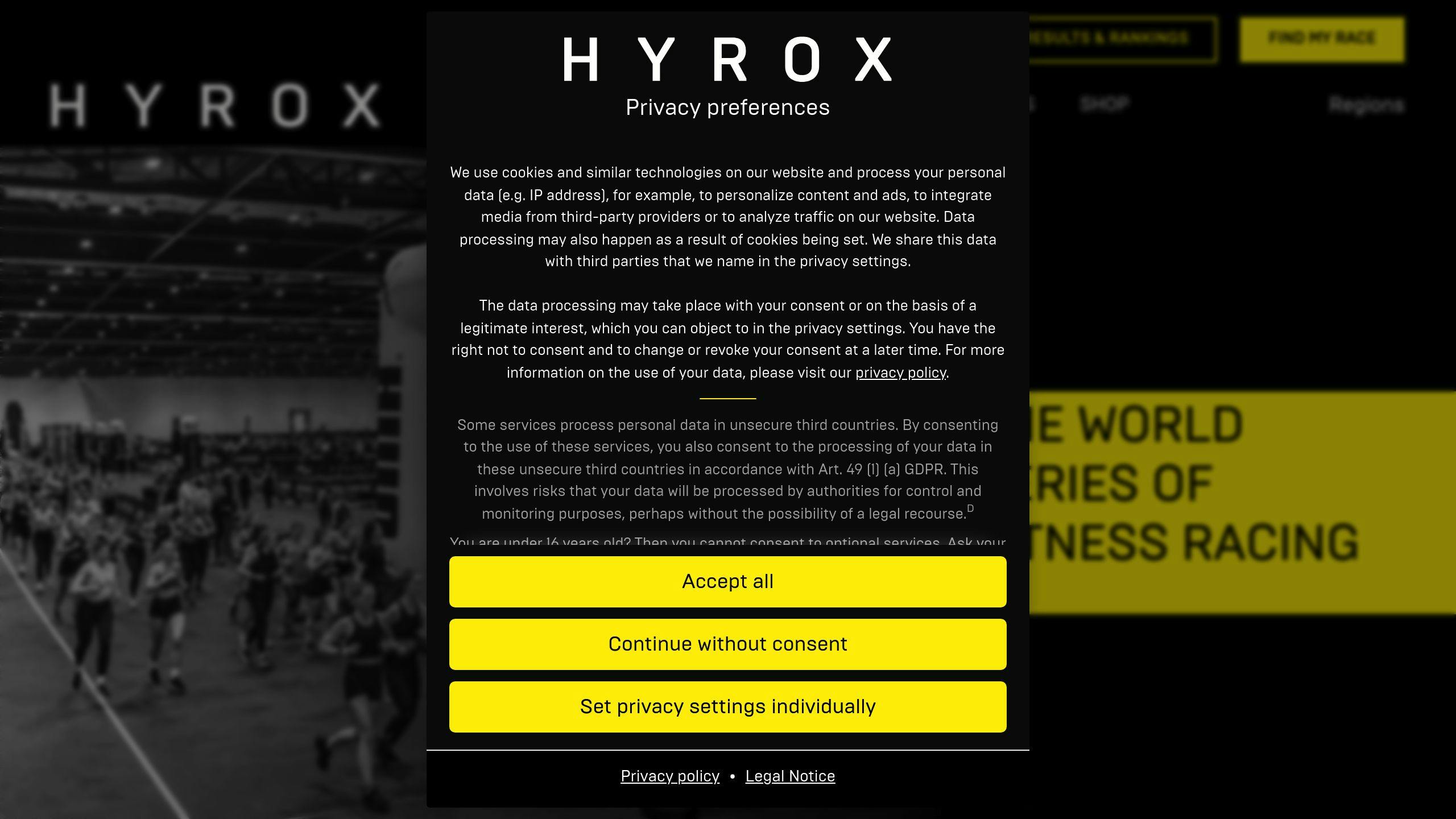Want to crush your next Hyrox race? It all starts with pacing. Managing your energy across 8km of running and 8 fitness stations is the key to avoiding burnout and performing at your best. Here are the 5 essential pacing strategies to help you succeed:
- Steady Running Pace: Keep your 1km splits consistent and manageable (75-85% of your max heart rate). Use a GPS watch and focus on effort, not speed.
- Efficient Erg Machine Pacing: Maintain sustainable stroke rates and focus on form - don’t go all-out, save energy for later.
- Controlled Sled Work: Start conservatively, focus on technique, and manage your effort to avoid energy drains.
- Quick Transitions: Smooth, practiced transitions between stations save precious seconds and keep your momentum.
- Build Intensity: Start at 70-75% effort, gradually increase, and finish strong with maximum effort in the final stages.
Quick Insight: Athletes with consistent pacing perform significantly better - at the 2022 World Championships, top finishers had only a 6-second difference between their fastest and slowest 1km runs. Follow these tips to master your pace and dominate your race.
How to Pace Yourself in HYROX

Tip 1: Maintain Steady Running Pace
Running accounts for about 50% of your total Hyrox race time, so having a solid pacing plan is essential. The goal? Find a rhythm you can sustain across all eight 1km runs while conserving enough energy for the workout stations.
Why Consistent Running Matters
Top athletes usually keep their kilometer splits within a 5-second range. This approach helps avoid burnout and keeps their minds sharp for the workout stations. Starting with controlled effort is a proven strategy in championships, as it minimizes lactic acid buildup and saves energy for the later stages.
How to Keep a Steady Pace
Here are some practical ways to stay consistent during your runs:
| Pacing Element | Target Range |
|---|---|
| Heart Rate | 75-85% of max |
| Perceived Effort | Moderate (can talk in short sentences) |
| Initial Pace | 70-80% of your 10K pace |
- Use GPS lap alerts to monitor your pace.
- Focus on effort rather than speed, especially as fatigue sets in.
Controlling your cardio output allows for quicker transitions between running and workout stations. A GPS watch can help you track each 1km segment, with pace alerts to keep you from going too fast or slowing down too much.
Adapting Your Pace to the Course
The course layout can change your pacing strategy. For example, adjust your stride length when approaching turns to keep your momentum steady. On inclines, focus on maintaining effort rather than pace, even if it means slowing down slightly. Use downhill sections to pick up speed naturally without pushing too hard.
As you approach workout stations, start easing your pace 100-200 meters beforehand. This gives your body time to adjust, preventing a sudden "system shock" when switching activities. Smart pacing on the running segments also sets you up for smoother transitions to sled work and better performance on erg machines, where technique is key.
Tip 2: Efficient Pacing on Erg Machines
When it comes to erg machines, pacing is everything. Unlike running, these machines require a measured approach to conserve energy for the challenges ahead.
Dialing In Your Erg Machine Pace
Consistency in stroke rates is just as important here as it is in running.
| Machine | Stroke Rate (strokes per minute) | Target Pace |
|---|---|---|
| SkiErg | 28-32 | 5-10 sec slower than 5K PR/500m |
| RowErg | 24-28 | 5-10 sec slower than 5K PR/500m |
For example, if your 5000m RowErg personal best is 20:00 (2:00/500m pace), aim for a controlled 2:05-2:10/500m pace during the 1000m station.
Mastering Technique for Better Efficiency
Good form is critical. On the SkiErg, engage your core and maintain a slight forward lean. For the RowErg, focus on a strong leg drive first, then follow through with your arms. This approach not only saves energy but also improves your overall performance.
"The key to success on the erg machines in HYROX is finding a sustainable rhythm that allows you to transition smoothly back to running. It's not about going all-out, but rather about efficient energy management." - Ben Smith, HYROX World Champion
Watch out for common mistakes like starting too aggressively, poor breathing patterns, relying too much on your arms, or neglecting core activation.
Turning Erg Work Into Active Recovery
Lauren Weeks suggests using the first 200m of each erg station to get your breathing under control and evaluate your energy levels. Breaking the 1000m effort into segments can make it more manageable:
- First 200m: Start at 60-70% effort, concentrating on form and steady breathing.
- Middle 600m: Gradually settle into your target pace while keeping technique sharp.
- Final 200m: Push harder if it fits your overall pacing strategy.
This structured approach helps you save energy for the sled stations, where you'll need to manage bursts of power carefully.
sbb-itb-8bcd5e0
Tip 3: Pacing Strategy for Sled Work
Sled work in a Hyrox race is a test of both strength and strategy. Like controlling your pace on erg machines, sled stations require careful effort management to avoid draining your energy too quickly. The sled push and pull are some of the toughest parts of the race, so balancing power and efficiency is key.
Managing Effort to Avoid Burnout
Think of sled work like managing heart rate zones during a run - keep your effort below 90% of your max heart rate to ensure you can recover while staying effective. Start conservatively, find a rhythm, and stick to a pace you can sustain.
| Phase | Target Effort | Key Focus |
|---|---|---|
| First 10-15m | 70-80% | Build rhythm and maintain form |
| Middle section | 80-85% | Keep a steady pace |
| Final 10m | 85-90% | Gradual acceleration |
For inspiration, elite athlete Hunter McIntyre's 2022 sled push and pull times (33 seconds and 52 seconds, respectively) highlight the importance of pacing discipline.
Techniques to Maximize Efficiency
Good technique can make sled work less exhausting. For the sled push, lower your body position, keep your back straight, and drive through the balls of your feet. Use your legs for power while keeping your arms locked to save upper-body energy.
When pulling, lean back slightly to use your body weight to your advantage. Take short, quick steps rather than long strides to maintain momentum.
To stay efficient throughout the station:
- Breathe rhythmically: Sync your breathing with each movement.
- Take strategic pauses: If your form slips, stop for 2-3 seconds to reset before continuing.
- Check your form: If your technique starts to break down, adjust your pace immediately.
- Stay mentally sharp: Divide the distance into smaller goals to stay focused and motivated.
This approach ties in with Tip 1's focus on steady running splits, emphasizing the importance of consistent effort. Nailing your sled pacing will set you up for smoother transitions and keep you mentally locked in for the rest of the race.
Tip 4: Effective Transition Management
Once you've nailed sled work efficiency, it's time to focus on transitions. These moments between Hyrox stations can make or break your race. Elite athletes handle transitions in just 5-10 seconds, balancing speed and control with slow jogs or brisk walks to keep their muscles engaged and blood circulating.
Quick and Controlled Transitions
| Transition Phase | Time (seconds) | Key Focus |
|---|---|---|
| Equipment Release | 2-3 | Clean, practiced movements |
| Station Exit | 3-4 | Controlled forward motion |
| Next Station Entry | 2-3 | Equipment preparation |
Here’s how to improve your transitions:
- Practice gear handling: Just like keeping steady running splits (Tip 1), develop muscle memory for quick and smooth equipment management.
- Use visual markers: Spot landmarks to guide your movement between stations.
- Control your breathing: Keep your breathing steady to manage fatigue and maintain focus.
"Transitions are the hidden opportunity in Hyrox. Master them, and you'll gain a significant edge over your competitors."
Mental Preparation for the Next Station
Transitions aren’t just about physical movement - they’re a chance to reset mentally and prepare for the next challenge. Treat them like mini-recovery periods while keeping your momentum steady, similar to how you approach erg stations for active recovery.
During transitions, focus on:
- Visualization: Picture yourself performing the next station with proper technique.
- Positive self-talk: Use short, motivating phrases to stay sharp.
- Mini-goals: Set small, achievable targets for the upcoming station.
- Breathing rhythm: Match your breathing pattern to your movement for better control.
Stay focused and avoid distractions like checking your watch too often or paying attention to other competitors. This mental preparation helps you stay on track and build intensity for the later stages.
Tip 5: Building Intensity Throughout the Race
This method ties into Tip 1's steady pacing and Tip 4's focus on smooth transitions, emphasizing how to manage your energy wisely during both running segments and workout stations.
Starting at a Controlled Pace
Kick off your race at about 70-75% of your maximum heart rate. This measured start helps your body adjust to the effort while keeping your mind sharp.
"The key to Hyrox success is not starting too fast. Build your intensity throughout the race, and you'll be amazed at how much you have left for the final push."
| Phase | Heart Rate | Effort (1-10) |
|---|---|---|
| First 3 stations | 70-75% | 6-7 |
| Middle | 75-85% | 7-8 |
| Final 3 | 85-90% | 8-9 |
These heart rate zones align with Tip 1's advice on maintaining steady cardio for consistent running splits.
Tracking and Adjusting Your Effort
Similar to the pacing strategy discussed in Tip 2, use measurable cues to gradually increase intensity. Keep an eye on physical markers like heart rate, breathing, and form to ensure you're on track. Stable heart rate during runs, controlled breathing, and proper form are all signs you're managing your effort well.
At the 2022 Hyrox World Championships, Tobias Lautwein gave a textbook example of this strategy. He held a steady pace of 3:30/km for the first 6 km, then sped up to 3:15/km for the final 2 km.
Finishing Strong with Maximum Effort
The wall ball station is your cue to push hard toward the finish line. Here’s how to finish strong:
- Start your final surge at the wall ball station.
- Increase your running pace by 10-15 seconds per kilometer in the last segments.
- Keep your movements sharp and efficient, even as fatigue sets in - building on Tip 3's advice about maintaining form under pressure.
Conclusion: Tailoring Pacing to Your Needs
Achieving success in Hyrox requires pacing strategies that match your strengths and fitness profile. By applying the five pacing principles discussed earlier, you can align these strategies with your unique abilities. For instance, if running is your strong suit but sled work is a challenge, you might push for a quicker pace during running while conserving energy for sled stations.
Here are some key performance factors to fine-tune your pacing approach:
| Performance Factor | Adjustment Consideration | Impact on Pacing |
|---|---|---|
| Running Strength | Higher tolerance for running pace (as shown in Tip 5's heart rate zone progression) | Maintain 75-85% max effort on runs |
| Recovery Rate | Endurance between stations | Shorter rest periods between stations |
| Technical Proficiency | Movement efficiency | Faster transitions, controlled power output |
To put these strategies into action, structured training programs like Hyrox Training Plans can help. These programs offer race-specific workouts and expert guidance to test and refine your pacing.



